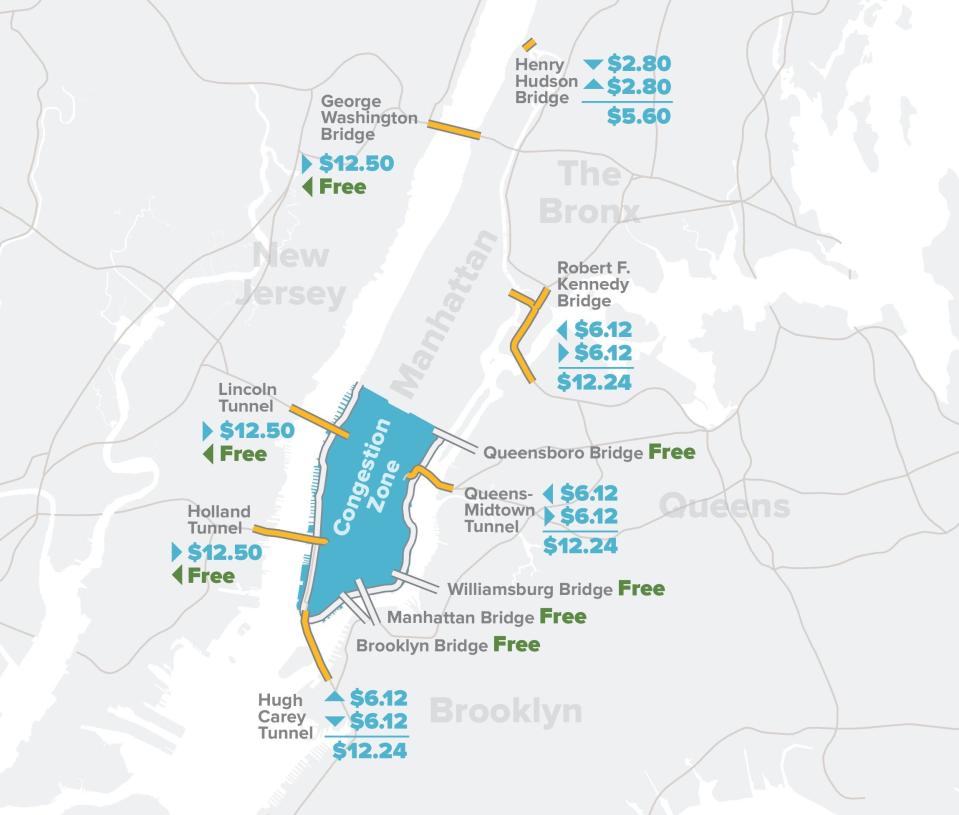Congestion pricing should be a win for New Jersey. Here’s why | Opinion
This fall marks the respective one- and 10-year anniversaries of Hurricane Ida and Superstorm Sandy. Both systems ravaged the tri-state region — and especially New Jersey, causing tens of billions of dollars in damage to the Garden State alone.
It’s clear that climate change is accelerating and its impacts are worsening thanks in no small part to our reliance on cars and the carbon they emit.
All you have to do is look at the roadways on the George Washington Bridge or Lincoln Tunnel on any given weekday and you’ll see clouds of exhaust fumes billowing in the air from the bumper to bumper traffic.
That’s why congestion pricing is such a crucial tool at our disposal to help curb our reliance on vehicular travel, thin out the jam-packed Hudson River crossings and improve public transit.
It’s why this is such a rare moment — while we have the momentum — to move forward with a smart plan to implement congestion pricing that’s equitable, comprehensive and fair to all commuters.
Congestion pricing remains controversial among many New Jersey residents who fear the cost increase will unfairly burden them.
As offices in New York City begin returning to hybrid models and more familiar pre-pandemic patterns, some argue that now is not the time to discourage commuters from entering the city.
Yet, according to a recent Regional Plan Association report, trans-Hudson commutes will rocket past pre-pandemic rates by 2050 in just about every possible mode – meaning that our already congested roads and transit systems will be pushed to the brink.
We prepare for this by both investing in infrastructure improvement projects like a new Penn Station, a new Port Authority Bus Terminal and the Gateway Program, which will double track capacity under the Hudson, and implementing measures like congestion pricing to encourage more transit ridership and clear up the already too-crowded tunnels and bridges.
More coverageCongestion pricing options studied by MTA would charge NJ drivers extra to get to NYC
And while many New Jerseyans choose to drive into the city, 78% of people entering the Manhattan Central Business District still rely on public transit — and New York City’s ailing public transit infrastructure.

From increasing delays and signal malfunctions to vulnerabilities to natural events like flooding, the system is not efficiently moving people from point A to point B — elongating the already lengthy commutes across the Hudson for the hundreds of thousands of New Jersey residents who use it every day.
The billions of dollars that congestion pricing will help raise will directly benefit the New Jerseyans who arrive in Manhattan and rely on the subway every day.
Of course, we must recognize that there are plenty of commuters who have no choice but to rely on their car from door to door. Contrary to popular belief, congestion pricing is their friend, too.
These commuters would see a dramatic reduction in traffic as more people are incentivized to take public transit, while non-commuters will find alternative times to travel into the city and use the roads.
By thinning out traffic, congestion pricing will save drivers countless hours of lost time per year normally spent stuck in unending traffic jams on one of the Hudson’s crossings as well as decrease traffic for trucks carrying goods throughout the region.
Once New Jersey drivers get into Manhattan, traffic flow will be better, too. Predictions estimate that traffic congestion in Manhattan could be reduced by as much as 20%, resulting in faster travel times for cars and buses.
But the benefits for our climate remain the most urgent and compelling reasons to implement congestion pricing now.
New Jersey as a whole is vulnerable to rising sea levels and superstorms — as we saw with Ida, Sandy and certainly plenty more in the years to come. Our increased reliance on cars and the fumes they spew into our atmosphere have a direct correlation to the worsening weather events we’re experiencing across the region with increased greenhouse gas emissions.
Studies have indicated that carbon dioxide emissions dropped by double digits in London and Stockholm after those cities adopted congestion pricing — numbers that would be transformative for our region.
Implementing congestion pricing sends a clear message — we must seek meaningful alternatives to our daily lives to prepare for changes to our environment. We don’t have the luxury to wait around for other solutions anymore.
It will encourage more of us to use public transportation instead of private vehicles that are inefficient and harmful to our environment. It will herald in significant improvements to transit systems so these networks can handle the influx of new users and evolve to be modern systems that meet the current and future needs.
There is not a one-size-fits-all approach to congestion pricing and a comprehensive program should be built with community buy-in that discourages toll shopping and protects arterial and local stress from increased congestion. That’s why we’ve advocated for all car drivers entering lower Manhattan pay the same rate, rather than pushing them to go out of their way. This approach would be a real win for New Jersey drivers because they already pay significant tolls to enter lower Manhattan, while the vast majority of drivers from Long Island, Westchester and Connecticut drive in for free.
This is the moment — while we have the support from elected officials at multiple levels, a hefty federal investment in infrastructure and numerous transformative public works projects across the region.
Let’s invest in the region's future and long-term sustainability by committing to greener alternatives, improvements to public transportation and investments to the region’s economic outlook.
Let’s move forward with congestion pricing now.
Tiffany-Ann Taylor is vice president for transportation for the Regional Plan Association. Zoe Baldwin is New Jersey director for the Regional Plan Association.
This article originally appeared on NorthJersey.com: NJ congestion pricing could be a win. Here's why

